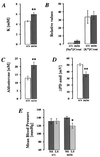Salt restriction induces pseudohypoaldosteronism type 1 in mice expressing low levels of the beta-subunit of the amiloride-sensitive epithelial sodium channel
- PMID: 9990093
- PMCID: PMC15577
- DOI: 10.1073/pnas.96.4.1732
Salt restriction induces pseudohypoaldosteronism type 1 in mice expressing low levels of the beta-subunit of the amiloride-sensitive epithelial sodium channel
Abstract
The amiloride-sensitive epithelial sodium channel (ENaC) is a heteromultimer of three homologous subunits (alpha-, beta-, and gamma-subunits). To study the role of the beta-subunit in vivo, we analyzed mice in which the betaENaC gene locus was disrupted. These mice showed low levels of betaENaC mRNA expression in kidney (approximately 1%), lung (approximately 1%), and colon (approximately 4%). In homozygous mutant betaENaC mice, no betaENaC protein could be detected with immunofluorescent staining. At birth, there was a small delay in lung-liquid clearance that paralleled diminished amiloride-sensitive Na+ absorption in tracheal explants. With normal salt intake, these mice showed a normal growth rate. However, in vivo, adult betaENaC m/m mice exhibited a significantly reduced ENaC activity in colon and elevated plasma aldosterone levels, suggesting hypovolemia and pseudohypoaldosteronism type 1. This phenotype was clinically silent, as betaENaC m/m mice showed no weight loss, normal plasma Na+ and K+ concentrations, normal blood pressure, and a compensated metabolic acidosis. On low-salt diets, betaENaC-mutant mice developed clinical symptoms of an acute pseudohypoaldosteronism type 1 (weight loss, hyperkalemia, and decreased blood pressure), indicating that betaENaC is required for Na+ conservation during salt deprivation.
Figures






References
-
- Rossier B C, Palmer L G. In: The Kidney: Physiology and Pathophysiology. Seldin D W, Giebisch G, editors. New York: Raven; 1992. pp. 1373–1409.
-
- Canessa C M, Schild L, Buell G, Thorens B, Gautschi I, Horisberger J D, Rossier B C. Nature (London) 1994;367:463–467. - PubMed
-
- Kosari F, Sheng S, Li J, Mak D-O D, Foskett K, Kleyman T R. J Biol Chem. 1998;273:13469–13474. - PubMed
-
- Canessa C M, Horisberger J D, Rossier B C. Nature (London) 1993;361:467–470. - PubMed
Publication types
MeSH terms
Substances
Grants and funding
LinkOut - more resources
Full Text Sources
Molecular Biology Databases

